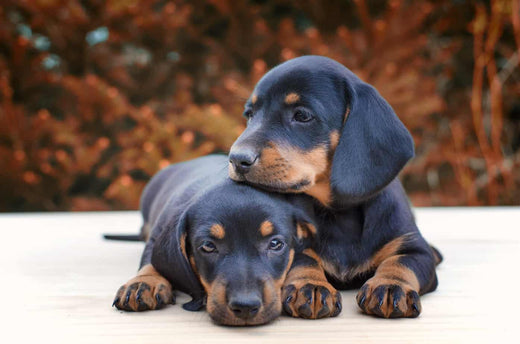
New Puppy Essentials Checklist
Don't wait for your new puppy to arrive before getting the essentials. The following puppy shopping list features all the must-haves that every new dog owner should have to hand.1. Puppy crate or bed
While many dogs choose to sleep on the couch or on their human's bed, remember that your new puppy doesn't yet know you. So the places where your scent is strong may be overwhelming to them initially. Therefore, you should prepare them a cozy space with no pungent smell, making it easy to put their scent down and find some comfort in this significant change. You can opt for a crate or a pet bed, or both to be on the safe side! A crate can be more comforting for anxious pups as you can drape blankets over the top and sides to give them more privacy. However, you can also buy hooded dog beds that provide a snug, cocoon-like feel.2. Food and water bowls
We recommend buying your pup a specific food and water bowl rather than just giving them one from the kitchen cupboard. This is because dog bowls are specially designed to a canine's shape and size. Stainless steel is the best choice as other materials such as plastic can cause allergic reactions and dog acne. Make sure the food bowl is relatively heavy, as this will reduce its sliding all over the floor as your pup eats. Some have non-skid rims or suction pads on the base to keep it in one place, perfect for hungry puppies who can't get enough food! Also, consider getting elevated bowls as these put less strain on a canine's neck, slow down the eating rate, and cause less mess.3. Puppy food and treats
Puppies need to eat food that is specially formulated for their young age. Puppy food is higher in calories, protein, and fat to support the period of rapid growth. If you feed a young puppy adult dog food, they will get hungrier faster and miss out on essential nutrients. Be sure to know how often your new puppy needs to eat too. For example, most breeds need four feedings a day between six to twelve weeks old. Stock up on treats, too, as these are handy when you start training your canine. There is a vast selection of dog treats available, but check they are suitable for puppies.4. Doggie toys
If this is your first time getting a puppy, prepare yourself for their high energy levels! Young dogs love to play, and although they tire quickly, it doesn't take them long to regain energy. Therefore, invest in a selection of dog toys, including ones that can be used in interactive play together and a few ones they can play with alone.- Puzzle toys are a great choice as they get your puppy's brain working and keep them occupied while you are busy or if you have to pop out.
- Small balls and toys they can chase are essential for getting their excess energy out.
- Chewable toys will help them through the uncomfortable teething stage.
5. An adjustable collar and a leash
Vets advise not to take a puppy out for walks until they are fully vaccinated (around 16-18 weeks) because their immune systems are still weak. However, your pup will still need to go outdoors to do its business. Regardless of whether your yard is secure, it's good practice to get your puppy used to being on a leash straight away. Not all collars and leashes are created equally, and some have safety concerns. Look for a breakaway dog collar that is soft, padded, and adjustable. You should never just attach a lead to a dog's neck collar, as this can cause choking. Instead, buy a harness that goes around their upper body. Retractable leashes are best as you can give them some freedom to run in an open field but easily keep them near you when close to traffic. Leashes come in different lengths, so check that it is not too short; 4 to 6 feet is ideal.6. Grooming and cleaning products
Puppy grooming has multiple benefits to their health and wellbeing. Grooming allows you to keep their skin, coat, nails, and other body parts in top condition, free from infections and ailments. In addition, establishing a regular dog grooming regime while young will help avoid future behavioral problems and contribute to bond building. Some standard grooming items you'll need are shampoos, conditioners, and brushes for taking care of their coat and a dog nail grinder for keeping their claws short. Ensure shampoos are suitable for puppies, and speak with your vet for recommended products as they can advise what is best for your puppy's breed and coat type. Once your puppy has all their adult teeth through (usually around 6 months), you will need a doggie toothbrush and toothpaste for teeth brushing. Different dog toothbrushes are available, but the finger-style ones are ideal for a puppy's mouth size. Stocking up on some additional cleaning products is also a good idea. For example, doggie wipes and paw plungers are excellent for cleaning your puppy's feet after being outside, and pee pads and poop bags can assist in toilet training.
7. Doggie first aid kit
Puppies tend to be quite accident-prone, so it's well worth having some medical supplies. Include things like an antiseptic wash and cotton wool to clean up cuts, antibiotic spray to prevent infection, styptic powder and bandages to stop the bleeding and protect wounds. Non-stick bandages are ideal for dogs as there is no nasty tape that sticks to their fur.8. Doggie ramp or stairs
Dog ramps and stairs are not only helpful for older dogs with mobility issues. Certain breeds like Labrador Retrievers have genetic dispositions that can lead to hip dysplasia if they go up and down stairs or steps while puppies. Doggie ramps and stairs can help your puppy get up small heights like onto the couch or bed. While doggie stairs can stop your excited pup from jumping up and getting injured, ramps are a safer choice as the flat surface takes more pressure off their growing joints. What’s more, dog ramps are easy to adjust as needed, and teaching young puppies how to use them is effortless.9. Pet Insurance
The experts at CanineJournal.com also recommend considering pet insurance for your new pup. The younger and healthier they are at enrollment, the less expensive it normally is (and reduced chances of them being denied coverage as they age since they have fewer preexisting conditions in youth). Learn more and find the best fit for your dog.
